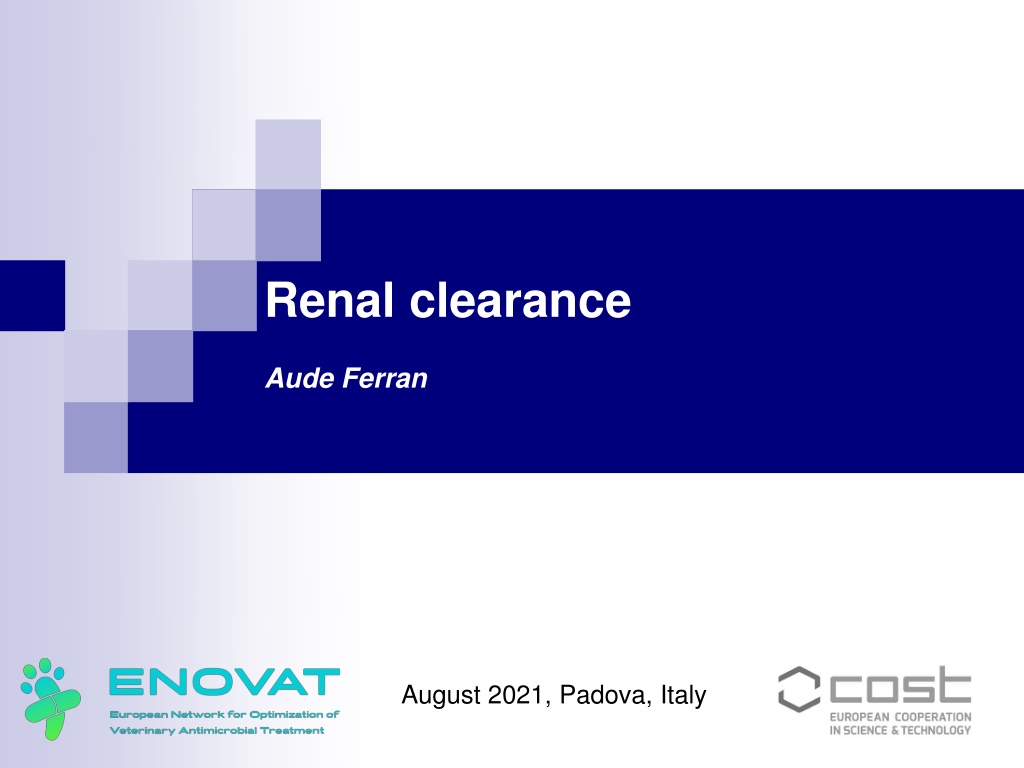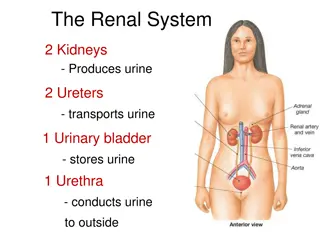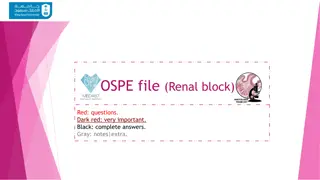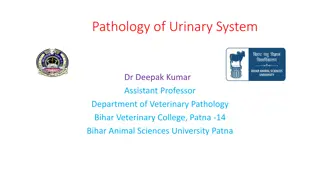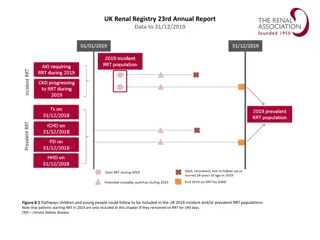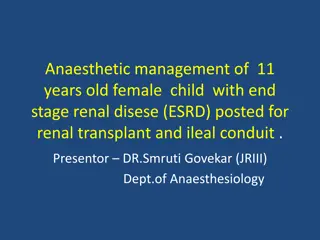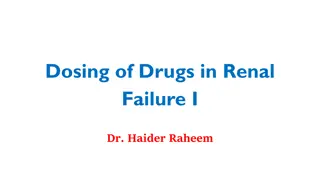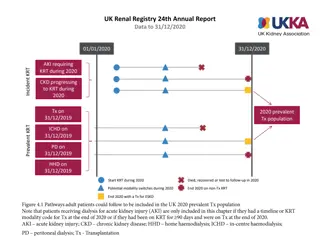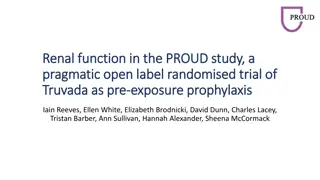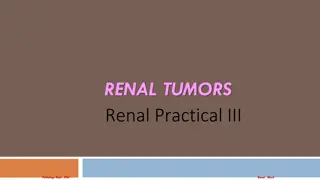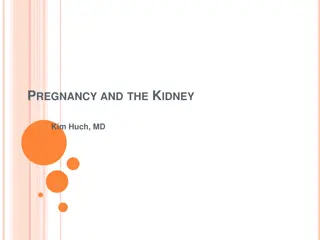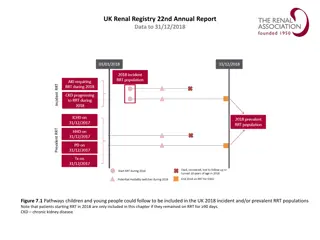Understanding Renal Clearance and its Physiological Mechanisms
This content delves into the concept of renal clearance, exploring its relation to lipophilicity and mechanisms such as glomerular filtration, tubular secretion, and reabsorption. The processes occurring at the nephron level and the vascularization scheme are detailed, along with a breakdown of physiological mechanisms like filtration, reabsorption, and secretion. Key points include the rates of renal elimination, filtration, secretion, and reabsorption, as well as factors influencing glomerular filtration rates and renal blood flow.
Download Presentation

Please find below an Image/Link to download the presentation.
The content on the website is provided AS IS for your information and personal use only. It may not be sold, licensed, or shared on other websites without obtaining consent from the author. Download presentation by click this link. If you encounter any issues during the download, it is possible that the publisher has removed the file from their server.
E N D
Presentation Transcript
Renal clearance Aude Ferran August 2021, Padova, Italy 1
Introduction Hydrophobic molecule Hydrophilic molecule Liver Kidneys More hydrophilic metabolite Urine 2
Introduction Note : relation between lipophilicity and renal clearance 10 Renal clearance (mL/min/kg) Beta-blockers NSAIDs 1 0.1 0.01 0.001 -3 -2 -1 0 1 2 Log D pH= 7.4 3 Smith, 1996, Med. Res. Rev.
Introduction Note : relation between lipophilicity and renal clearance Carboxylic acids 15 Renal clearance (mL/min/kg) Renal clearance Hepatic clearance 10 5 0 -1 0 1 2 Log D Smith, 1996, Med. Res. Rev.
Renal clearance Introduction Physiological mechanisms and clearance Glomerular filtration Tubular secretion Reabsorption Methods to measure renal clearance 5
Introduction Processes of elimination, secretion and reabsorption occur at the nephron s level Scheme of a nephron and its vascularisation 6
Physiological mechanisms Filtration Reabsorption (passive) Collecting tube Proximal tubule Distal tubule Glomerulus Secretion (active) Loop of Henle Scheme of a nephron 7
Physiological mechanisms To urine To plasma Raterenal elimination= Ratefiltration + Ratesecretion - Ratereabsorption Raterenal elimiationn Ratefiltration Ratesecretion - Ratereabsorption = + C C C ClRenal = Clfiltration + Clsecretion - Clreabsorption 8
Physiological mechanisms ClRenal = Clfiltration + Clsecretion - Clreabsorption 9
Physiological mechanisms Glomerular filtration FLOW RATES Renal blood flow: 20-25% of cardiac output Glomerular Filtration Rate (GFR): 10% of renal blood flow GFR 10
Physiological mechanisms Glomerular filtration Albumin = 0.004 g/L = ULTRAFILTRATION Passive mechanism Molecules of MW < 68 kDa Only the free fraction is filtered Albumin = 40g/L Haraldsson et al, Physiol Rev 88: 451-487, 2008 11
Physiological mechanisms Glomerular filtration The main factor that determines filtration is the molecular weight of the substance Inulin 100 Ultrafiltration/plasma Myoglobin Albumin (%) 50 0 20000 69000 PM(da) 12
Physiological mechanisms Glomerular filtration Ratefiltration = GFR x Cfree Cfree = fu x Ctot Ratefiltration = GFR x fu x Ctot ?????????????? ???? =?? ???? ??? ???? ????????????= = ?? ??? ????????????= ?? ??? 13
Physiological mechanisms Glomerular filtration Estimated filtration capacity If ClRenal = Clfiltration There is only filtration in kidney QRenal x ERenal = fu x GFR ??? ?????? ERENAL= 1 . 0 ??????= And if fu = 1 Filtration alone can purify at maximum 10% of renal blood flow 14
Physiological mechanisms Glomerular filtration Application Measurement of GFR Assessment of renal function Conditions Molecule with only renal elimination Molecule filtered, not secreted, not reabsorbed No binding to plasma proteins ???????= ???????= ??? 15
Physiological mechanisms Glomerular filtration Conditions Molecule with only renal elimination Molecule filtered, not secreted or reabsorbed No binding to plasma proteins INULINE or creatinine Completely filtered (no binding to plasma proteins) Not reabsorbed Not secreted Cltotal_inu or creat = GFR in humans 16
Physiological mechanisms ClRenal = Clfiltration + Clsecretion - Clreabsorption 17
Physiological mechanisms Tubular secretion Secretion (active) FEATURES Proximal Convoluted Tubule (PCT) Active Transport Saturable process = possible competition 18
Physiological mechanisms Tubular secretion Examples PAH Penicillins Salicylate Sulfonamides Furosemide Thiazides Cephalosporins Fluoroquinolones Note : secretion of penicillin can be limited by concomitant administration of probenecid 19
Physiological mechanisms Tubular secretion If Erenal higher than 0.1 => there is a secretion Note: examples of molecules with different renal extraction coefficient Low (<0.3) Medium (0.3-0.7) High (>0.7) Amoxicillin Cimetidin Glucuronides Digoxin Sulfates Gentamicin Tetracycline 20
Physiological mechanisms Tubular secretion PAH ParaAminoHippuric acid Filtered And completely secreted by the TCP =>Erenal=1 =>PAH clearance is equal to renal plasma flow = Method to estimate the renal plasma flow in humans 21
Physiological mechanisms ClRenal = Clfiltration + Clsecretion - Clreabsorption 22
Physiological mechanisms Reabsorption ACTIVE (proximal convoluted tubules) Transporters / endogenous compounds Organic molecules: glucose, amino acids, vitamins Electrolytes : Na+,Cl -, Ca++, K+, HCO3- PASSIVE Water follows Na+(concentration of primary urine in final urine) Xenobiotics 23
Physiological mechanisms Reabsorption Individual factors urine output urine pH Xenobiotic Factors influencing reabsorption Physico-chemical properties of the drug lipophilicity ionization molecular weight 24
Physiological mechanisms Reabsorption Influence of the urinary pH Rate of elimination 5 6 6.5 8 8.5 urine pH - + Weak acids (AH =reabs) (A- = no reabs) - (B= reabs) + Weak Bases (BH+= no reabs) 25
Phenylbutazone Phenylbutazone urine concentrations of urine concentrations of horses horses at different pH
Physiological mechanisms Summary: different combinations Inulin 100 Sulfanilamide 95 Ampicillin 90 Sulfamethizole 20 Cephalexin 80 444 123 134 40 246 21 100 55 224 122 278 Kamiya et al. J Pharm Sci, 1983, 72:440 Provided values are normalized for inulin glomerular filtration 27
Methods of measurement dX dt RENALE= u CL ( ) t C Collection of urine ??/ ? ????????, ? ???????= Plasma collection 28
Methods of measurement Application to GFR measurement by creatinine Conc Plasma collection Cmean, T XU / T Collection of urine time 29
Methods of measurement Plasma collection Collection of urine dX dt RENALE= u CL ( ) t C Conc ??/ ? ????????, ? ???????= X TOTALE u, AUC = CL AUC RENALE TOTALE time Collection of urine XU 30
Summary GFR fu Passive (ionization) Active transports ClRenal = Clfiltration + Clsecretion - Clreabsorption 31
